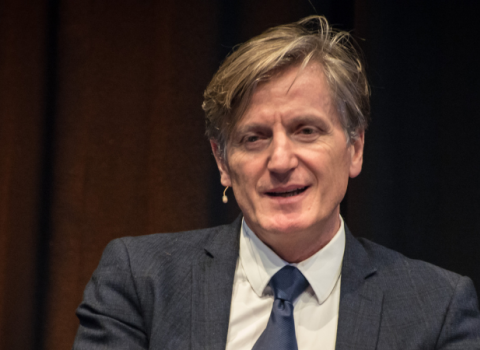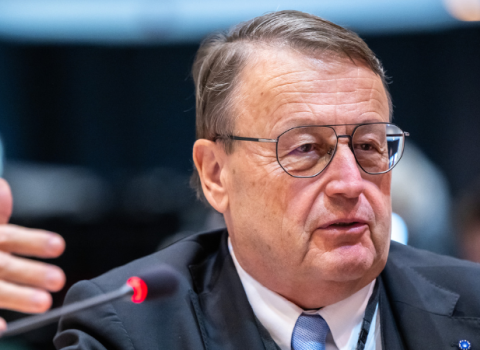The European Institute of Innovation & Technology (EIT) is calling for its funding to be increased to €4 billion in the 2014 – 2020 budget, saying the €309 million it is getting in the current financial cycle is not sufficient to attract industrial partners into its Knowledge and Innovation Communities (KICs).
The big increase in EU funding is needed both to support the three existing KICs, which may need “one more push” with another round of financing, and to launch further KICs after 2014, Alexander von Gabain, the EIT’s Chairman-Elect told a Science|Business seminar held last week.
“We cannot change Europe with the same amount of money that was put into a single Austrian biotech company,” Von Gabain said, referring to Intercell AG, the vaccines company he co-founded in the late 1990s.
The EIT sets out its case in a Strategic Innovation Agenda, presented to the European Commission last month, in which it says the current budget of €309 million, “Falls short of the benchmark amount needed in the EU to have a real innovation impact.”
It also compares its miserly budget to the €10 billion the European Research Council (ERC), its counterpart in basic research, received during the past four years. The distinction between the two bodies is that the ERC is providing 100 per cent grants for the projects it funds, while the EIT provides up to 25 per cent of the cost, relying on this to entice partners who are willing to put in the remaining 75 per cent.
Attracting powerful KIC partners
This need to attract private sector funding is at the crux of the EIT’s case for greater funding. “The EIT must increase the level of KICs funding […] to make them more attractive to future powerful KIC partners. Currently, the investment funding is considered to be marginal, if not sub-marginal for this purpose,” the Strategic Innovation Agenda says.
The early signs are that the Institute will get more money, with the EU 2014 – 2020 budget proposal, put forward by the European Commission last month, referring to “a significantly increased budget” for the EIT.
The EIT opened in 2008 with a brief to help bridge the gaps between research, industry and education by acting as a seed investor for the KICs, which involve long-term collaborations between academics, companies and educators in several European countries. The three existing KICs are specialising in developing and commercialising products in the areas of energy, information technology and climate change.
One of the key factors determining the EIT’s budget is how many KICs are launched in future. The Strategic Innovation Agenda makes the case for nine more, with three to be launched in 2014, three in 2017 and a further three in 2019.
Don’t grow too fast
Not everyone at the seminar was convinced about creating so many new KICs. John Vassallo, Vice President for EU Affairs at Microsoft, said he would prefer to see fewer KICs that really produce results, rather than many KICs and many centres of excellence, which cannot be truly excellent if they are so numerous. Dutch MEP Lambert van Nistelrooij agreed, saying, “Don’t grow too fast is my message.”
While underlining that growing the EIT would be a step-by-step process, Von Gabain stressed more seed money is needed to build up innovative entrepreneurial companies. “Innovation is always a risk. We are a fund that is a seed fund. We must be able to invest in seven, eight, nine, ten [projects], knowing that some will fail,” he said.
KICs differ in many ways from other EU research programmes and have had to break new ground in establishing their model for collaboration. For example, they had to devise legal structures that are compatible with co-locating activities in several countries. “KICs are legal entities, not joint ventures or partnerships coming together to milk the cow of EU funding,” noted Xavier Prats Monné, deputy director general at the Commission’s DG Education and Culture.
Getting innovation off the ground
The first three KICs have experienced a number of teething problems, including delays in getting the money flowing and agreements signed. The initial phase has been a “hard and tough time,” said Elmar Dorner, Director of SAP Research Karlsruhe. As a result, SAP pulled back from two of the three KICs in which it was originally involved.
Getting the innovation element off the ground is also proving difficult. As a company that needs to sell innovative products, “We really hope we get the innovation part better,” Dorner said.
There is also a need for more flexibility in areas including contracting, intellectual property rights and ramping-up spin-offs companies, believes Dorner. On the plus side, the KICs are expected to provide, “A long-term view and reliability with the partner network,” said Dorner.
Vassallo stressed that companies want to see returns on the money they put in. To do this KICs should have measurable targets, such as the number of start-ups generated and the number of ideas that get to market.
In the 2014 – 2020 budget the EIT will be grouped into the Common Strategic Framework, along with the renamed Framework Programme, now dubbed Horizon 2020 - the Framework Programme for Research and Innovation; and the Competitiveness and Innovation Framework Programme, which supports SMEs.
Retaining EIT’s flexibility
The idea is to bring all research-related budgets under one umbrella, to simplify procedures, make rules more consistent and predictable, and remove overlap and duplication between programmes. The EIT and the KICs required a significant degree of flexibility and independence from EU financial rules to get things moving and the seminar heard that steps to rein in this freedom will be met with resistance because it would run counter to the demands of fast-pace innovation and dynamic entrepreneurship.
Although, “Common rules for the Common Strategic Framework sounds a compelling message,” the specific nature of the EIT must not be forgotten, said Prats Monné. “Valuable ideas could become impractical in reality,” he warned.
Vassallo too, underscored the importance of the EIT being able to retain its flexibility. “The EIT must not now be put back in a straitjacket,” he said.
The seminar also heard the preliminary findings of a public consultation carried out by the European Commission to gather opinions on what the EIT has achieved to date and the direction it should take in the future. These were presented by Lucia Recalde Langarica, head of unit at the Commission’s directorate-general Education and Culture.
Five general conclusions had already emerged, she said, with a broad endorsement of the knowledge triangle between industry, research and education within the EIT; a consensus that the EIT’s added value must be tangible; a need for flexibility, especially to get business involved; a call for wider dissemination across the EU of the progress, good practice and results from the KICs; and a need to consolidate the three existing KICs.





 A unique international forum for public research organisations and companies to connect their external engagement with strategic interests around their R&D system.
A unique international forum for public research organisations and companies to connect their external engagement with strategic interests around their R&D system.